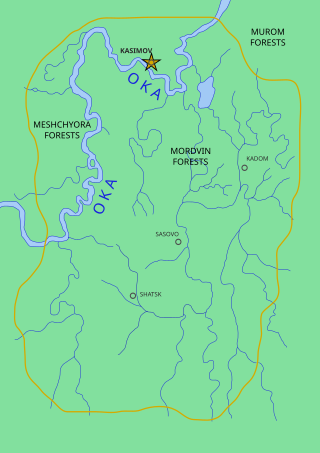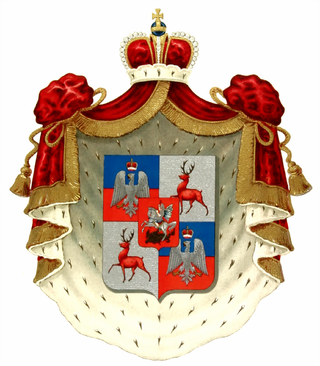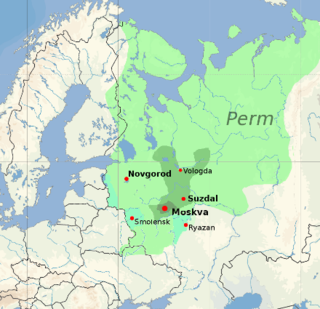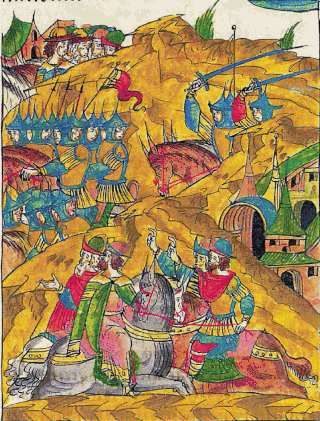Related Research Articles

The Tatars, formerly also spelled Tartars, is an umbrella term for different Turkic ethnic groups bearing the name "Tatar" across Eastern Europe and Asia.

Vasily I Dmitriyevich was Grand Prince of Vladimir and Moscow from 1389. He was the heir of Dmitry Donskoy, who reigned from 1359 to 1389.

The Khanate of Kazan was a Tatar state that occupied the territory of the former Volga Bulgaria between 1438 and 1552. The khanate covered contemporary Tatarstan, Mari El, Chuvashia, Mordovia, and parts of Udmurtia and Bashkortostan; its capital was the city of Kazan. It was one of the successor states of the Golden Horde (Mongol state), and it came to an end when it was conquered by the Tsardom of Russia.

The Crimean Khanate, self-defined as the Throne of Crimea and Desht-i Kipchak, and in old European historiography and geography known as Little Tartary, was a Crimean Tatar state existing from 1441–1783, the longest-lived of the Turkic khanates that succeeded the empire of the Golden Horde. Established by Hacı I Giray in 1441, it was regarded as the direct heir to the Golden Horde and to Desht-i-Kipchak.

Kasimov is a town in Ryazan Oblast, Russia, located on the left bank of the Oka River. Population: 33,491 (2010 Census); 35,816 (2002 Census); 37,521 (1989 Soviet census); 17,000 (1910).

The Qasim Khanate was a Tatar-ruled khanate, a vassal of the Principality of Moscow, which existed from 1452 until 1681 in the territory of modern Ryazan Oblast in Russia with its capital at Kasimov, in the middle course of the Oka River. It was established in the lands which Grand Prince Vasily II of Moscow presented in 1452 to the Kazan prince Qasim Khan, son of the first Kazan khan Olug Moxammat.

The House of Shuysky was a Russian family of boyars, claiming descent from Dimitri Konstantinovich, grand prince of Nizhny Novgorod-Suzdal and Prince Andrey Yaroslavich. The surname is derived from the town of Shuya, of which the Shuiskys gained ownership in 1403. From 1606 to 1610, Vasili Shuisky ruled as tsar over Russia during the Time of Troubles.

The Volga Tatars or simply Tatars, and occasionally by the historical Turko-Tatars, are a Kipchak-Bulgar Turkic ethnic group native to the Volga-Ural region of western Russia. They are subdivided into various subgroups. Volga Tatars are the second-largest ethnic group in Russia after ethnic Russians. Most of them live in the republics of Tatarstan and Bashkortostan. Their native language is Tatar, a language of the Turkic language family. The predominant religion is Sunni Islam, followed by Orthodox Christianity.

The Tokhtamysh–Timur war was fought from 1386 to 1395 between Tokhtamysh, the khan of the Golden Horde, and the warlord and conqueror Timur, founder of the Timurid Empire, in the areas of the Caucasus Mountains, Turkestan and Eastern Europe. The battle between Timur and Tokhtamysh played a key role in the decline of Mongol power over the Russian principalities.

The Russo-Kazan Wars were a series of short, intermittent wars fought between the Grand Principality of Moscow and the Khanate of Kazan between 1437 and 1556. Most of these were wars of succession in Kazan, in which Muscovy intervened on behalf of the dynastic interests of its main ally, the Crimean Khanate. For most of the period, neither side sought to conquer the other, until Ivan the Terrible decided to annex Kazan upon the successful 1552 siege, which was followed by a rebellion lasting until 1556.

The Principality of Moscow (1263–1363), later the Grand Principality of Moscow (1363–1547), was a medieval Russian principality. Its capital was the city of Moscow.

The Muscovite War of Succession, or Muscovite Civil War, was a war of succession in the Grand Duchy of Moscow (Muscovy) from 1425 to 1453. The two warring parties were Vasily II, the son of the previous Grand Prince of Moscow Vasily I, and on the other hand his uncle, Yury Dmitrievich, the Prince of Zvenigorod, and the sons of Yuri Dmitrievich, Vasily Kosoy and Dmitry Shemyaka. In the intermediate stage, the party of Yury conquered Moscow, but in the end, Vasily II regained his crown.

Ulugh Muhammad or Muhammad Khan was a medieval Tatar statesman, Gengisid, Khan of the Golden Horde, ruler of Crimea (1437), and the founder of the Khanate of Kazan, which he ruled from 1438–1445. He was the son of the oglan Ichkile Hassan and the cousin of Tokhtamysh. He received the nickname "Ulugh", meaning older or large, in contrast to Küchük Muhammad, meaning younger or small.

Vasily Demitryvich Kirdyapa was the eldest son of Dmitri Konstantinovich of Suzdal and Nizhny Novgorod, a Prince of Suzdal (1364–1382) and Gorodets (1387–1403). He was the ancestor of the senior branch of a Rurikid noble family, and the Princes Shuysky.

The Grand Duchy of Moscow-Volga Bulgars War of 1376 was organized by princes Dmitry Donskoy of Muscovy, and Dmitry Konstantinovich of Nizhny Novgorod-Suzdal. The combined Muscovite–Suzdalian army was led by Moscow Governor Dmitry Mikhailovich Bobrok Volynskyy, and Dmitry of Suzdal's sons Vasily and Ivan Dmitriyevich. Volga Bulgaria, which was at the time an ulus of the Golden Horde, was ruled by emir Hassan Khan and Horde protégé Muhammad Sultan.

The Mishar Tatars, previously known as the Meshcheryaki (мещеряки), are the second largest subgroup of the Volga Tatars, after the Kazan Tatars. Traditionally, they have inhabited the middle and western side of Volga, including the nowadays Mordovia, Tatarstan, Bashkortostan, Ryazan, Penza, Ulyanovsk, Orenburg, Nizhny Novgorod and Samara regions of Russia. Many have since relocated to Moscow. Mishars also comprise the majority of Finnish Tatars and Tatars living in other Nordic and Baltic countries.

The Battle of Belyov was fought in 1437 near Belyov between the troops of the Grand Duchy of Moscow under the command of Dmitry Shemyaka and Tatars led by Ulugh Muhammad. The result of the battle is interpreted completely differently in different sources.

The 1439 siege of Moscow was a ten-day siege of Moscow, then the capital city of the Grand Duchy of Moscow, by Ulugh Muhammad, the Tatar Khan of the Kazan Khanate, during the First Russo-Kazan war.
References
- ↑ "КАЗАНСКОЕ ХАНСТВО". www.spsl.nsc.ru. Retrieved 2023-07-10.
- ↑ "КАЗАНСКОЕ ХАНСТВО". КАЗАНСКОЕ ХАНСТВО.
В начале апреля 1439 г. войска Улу-Мухаммеда подошли к Нижнему Новгороду и почти без сопротивления заняли его. В течение мая 1439 г. татары дошли до Москвы, разоряя по пути русские селения, грабя население, угоняя скот.Авангард татарского войска 2 июня 1439 г. вошел в Москву в Замоскворечье и 3 июня переправился через Москва-реку в район Зарядья. Окружив Кремль, татары пытались взять его приступом в течение двух недель, ища к тому разные подходы. Однако это не дало никаких результатов.Разорив посады, Зарядье и пряузную часть Белого города, татарское войско 13 июня 1439 г. оставило Москву. На обратном пути татары сожгли Коломну и покинули Московское княжество.
- ↑ "Казанское ханство. Территория и население". tatarhistory.ru.
Между ними произошло несколько военных столкновений: под Белевым в 1438 и под Суздалем в 1445 году. Василий II потерпел крупное поражение и попал в плен. Однако в том же 1445 году за большой выкуп был отпущен.